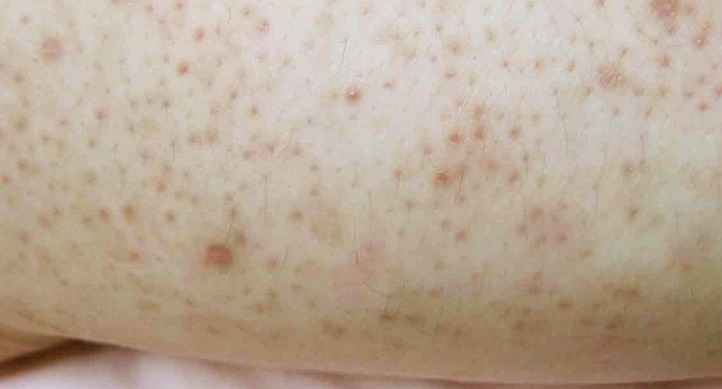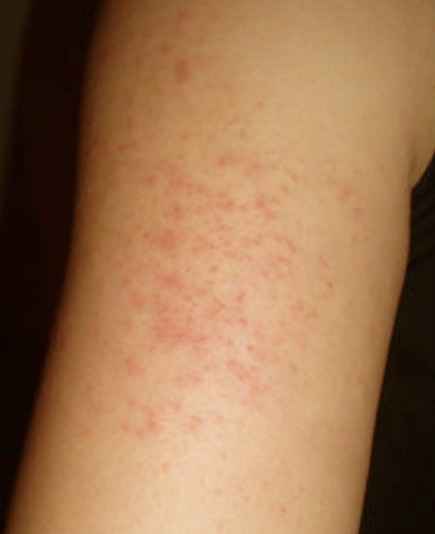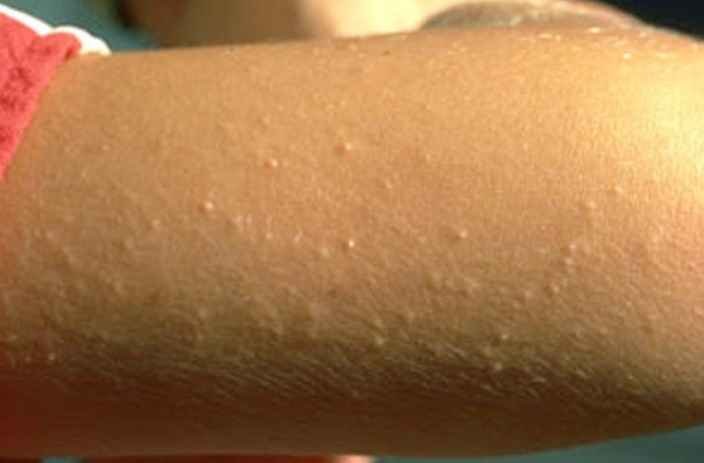Keratosis Pilaris
Rough skins with pimple-like bumps do not give you a good outlook. Instead they alter the smoothness of your face or other parts of the body and keep you worried most of the times. Come to think of it, who really want to look ugly? Unfortunately, some medical conditions like keratosis pilaris offer you what you never bargained for.
If you are a victim of this condition or you know of anyone who is suffering from it, you should worry less because the problem is not as serious as you think. It is manageable. In this post, we shall present you all the information you need to enable you take a good care of yourself and lead a normal life.
What is Keratosis Pilaris?
This is a skin condition that is brought about by excessive production of keratin by the body. Keratin is a protein substance produced and deposited on the outer layer of the skin in order to protect it from damage, harmful ultraviolet light, and microorganisms that may invade the body, like bacteria.

Picture of Keratosis pilaris
When the body produces excess keratin, it is deposited around hair follicles on the skin, leading to the formation of small bumps that may look like pimples. These make the skin feel very rough. This condition is then referred to as keratosis pilaris.
It is a very common skin condition and poses no real threat to life. It may, however, be a symptom of an underlying body ailment.
Keratosis Pilaris may look like other skin conditions like acne, eczema, and xerosis. A close variant is follicularis faciei et colli. It is thought to have genetically originated from keratosis pilaris. Its symptoms include extreme darkening of the skin (hyperpigmentation), hair loss, discoloration of the face and neck, and blocking of hair follicles. Other diseases that may look like keratosis pilaris are milia, folliculitis, lichen spinulosus, keratosis follicularis and perforating folliculitis.
How Does Keratosis Pilaris Look like?
Keratosis pilaris is characterized by many small bumps on the skin that may be mistaken for pimples. The skin may feel very rough, almost like sandpaper. The affected part looks like the skin of a goose or a plucked chicken, which has led to the condition being otherwise known as chicken skin.
In addition, blood vessels on the affected skin dilate towards the surface, making the skin appear red or very pink. The bumps are red, white or brown. The affected skin may also be very dry and appears scaly.
It usually affects the following areas:
- Thighs (mostly upper thighs and also the back of thighs)
- Legs
- Arms (forearm and upper arm, sometimes concentrating on the elbow. Occasionally, it spreads to the armpit)
- It can also be commonly found on the back of legs.
- Face (on the cheeks and sometimes on the chin)
- Buttocks
- Chest
Symptoms
These are some of the most common signs of keratosis pilaris:
- Small bumps that are usually painless on parts of the skin such as upper arms, thighs, cheeks, and buttocks.
- Dry skin that may appear scaly
- The skin may feel very rough on the affected parts
- Appearance and disappearance of these bumps with different climates. They often appear in climates with
- little humidity, for example, winter, then reduce or even completely disappear in summer, where the air is more humid.
- The skin may look like it has a lot of goose bumps, or resemble that of a plucked chicken
- The bumps may be white, red, pink, brown or black, depending on one’s skin color
Causes
Keratosis pilaris is caused by deposits of excess keratin on the hair follicle. It causes a formation of small hard bumps that make the skin feel rough.
Doctors have not found out what exactly triggers the production and deposit of the excess keratin. It is however thought to come from genetic skin conditions and diseases. It could also be symptomatic of other body conditions and skin diseases such as eczema and ichthyosis vulgaris.
Also, people who tend to be in constant contact with water, and those with dry skin are more likely to develop this condition. Other studies show that people with coiled hair follicles are more vulnerable.
Diagnosis
Usually, a doctor can tell keratosis pilaris by just looking at the affected skin. As it is usually genetic, family history is also an important lead.
Skin biopsy is performed under abnormal circumstances. Results for this skin condition usually include thickening of the epidermis which is the outer layer of the skin (epidermal hyperkeratosis), an increased population of granular cells of the epidermis (hypergranulosis) and some inflammation of the upper dermis, which is the layer of skin below the epidermis (mild superficial perivascular lymphocytic inflammation).
When to see a doctor
- If keratosis pilaris does not respond to home treatment and therapy
- If it comes along with other vital symptoms such as fever and vomiting. It could be a symptom of other disease conditions.
- If it becomes very painful. Normally, the skin affected by keratosis pilaris is not painful but may be a little itchy.
- If creams and lotions do not lessen the itchiness
Treatment
As keratosis pilaris is harmless, there is no prescribed treatment for it. It gradually disappears, usually with age. One can use creams, lotions and laser treatment to improve the appearance of the affected skin or reduce the discomfort. One is advised to use moisturizing skin care creams and practice self-improvement tips like drinking a lot of water to reduce instances of dry skin. If these do not work, the doctor will prescribe certain creams and lotions.
Topical exfoliants are creams to help with removal of dead cells. They reduce the appearance of bumps and improve how the skin looks. They are also important in moisturizing the skin. They usually contain alpha-hydroxy acid, salicylic acid, lactic acid, and urea. These creams may be prescribed or found over-the-counter depending on their concentration. Additionally, the acid they contain may redden the skin or make it itchy. They are therefore not recommended for children.
Topical retinoids help reduce plugging of the skin follicles. Their source is usually rich in Vitamin A. They contain tazarotene and tretinoin. Some examples of topical retinoids are Renova, Avita, Retin-A, Tazorac, and Avage. They, however, tend to make the skin dry and irritate it. They are therefore not recommended for pregnant or lactating mothers. They should be delayed for use after pregnancy.
Laser treatment is sought where creams and lotions fail to work. Lasers reduce the redness, swelling, discoloration and improve the skin texture.
The goal of treatment is not to cure keratosis pilaris, but to reduce the appearance of the small bumps, and to smoothen the skin texture. Application of creams and lotion may work only after long periods of time.
Here are a few home remedies and ways to contain the condition:
- Use warm water to bathe and avoid excessively hot water as it quickly dries the skin.
- Limit the amount of time you spend in water
- Avoid scratching or picking your skin
- Use humidifiers in the house to add moisture to the air. Keratosis pilaris is less likely to progress in humid conditions.
- Constantly apply moisturizers on the skin to keep it from drying up
- Drink plenty of water and fluids that hydrate the body to avoid drying up and scaling of the skin
- Use only approved soaps and creams on your skin to avoid skin damaging products
- Use topical exfoliant and retinol lotions and creams to assist with removal of dead skin
- Avoid wearing clothes that are too tight as they cause friction on the affected skin
- Apply coconut oil to the affected skin, especially on the legs and back of legs. It has some anti-inflammatory properties.
Pictures of Keratosis pilaris
Collection of Photos, Images, Pictures of Keratosis pilaris…



Who is most affected with Keratosis pilaris?
Keratosis pilaris may occur in people of all ages but mostly develops in a child, toddler, and adolescent. It usually clears by the age of 30.
It is also prevalent in people (mostly children) with skin conditions such as atopic eczema and ichthyosis vulgaris.
The skin condition may also extend into adulthood. It is slightly more prevalent in women than men.
When does Keratosis pilaris go away?
It clears in climates with high humidity, for example, in summer. It is known to become worse in winter when the air is generally dry.
In the long term, keratosis pilaris clears by the age of 30.
What is the best lotion for Keratosis pilaris?
Dermatologists recommend the use of lotions with a high content of lactic acid (such as AmLactin, Lac-Hydrin, and Cetaphil), alpha-hydroxy acid lotions, urea lotions (for example Urix 40, Carmol 20 and Carmol 10), salicylic acid lotions (Salex) and OTC moisturizing lotions such as Purpose and Lubriderm. One should also use skin cleansers, for example, Dove, Eucerin, and Curel.
Is Keratosis pilaris Contagious?
This skin condition is not contagious but has proven to be genetic. Family members are likely to develop it not from a transmission, but by inheritance.
Conclusion
Keratosis pilaris is a skin condition that is very common and affects children and young adults. It is not life-threatening and does not require treatment. It clears on its own by the time one is 30 years old. The best way to manage this condition is the use of moisturizing creams and lotions, particularly those that contain acids such as lactic acid and urea.
It is important to note that treatment of keratosis pilaris is a continuous process, and will not show any visible results until after weeks of continued therapy. One should not expect immediate results, and should not stop treating the skin. The best treatment, however, is taking care of your skins in all ways possible. It will not only help heal keratosis pilaris but also prevent other skin conditions.